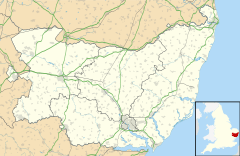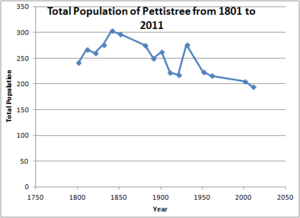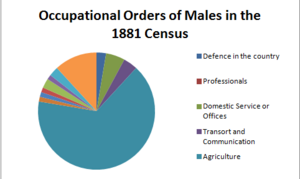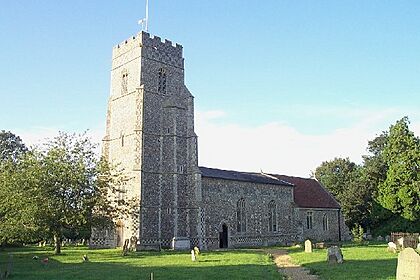Pettistree facts for kids
Quick facts for kids Pettistree |
|
|---|---|
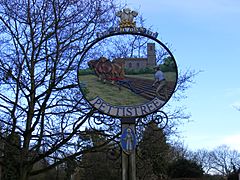 Village Sign |
|
| Population | 194 (2001) |
| OS grid reference | TM 30510 53679 |
| District |
|
| Shire county | |
| Region | |
| Country | England |
| Sovereign state | United Kingdom |
| Post town | Woodbridge |
| Postcode district | IP13 |
| Dialling code | 01728 |
| Police | Suffolk |
| Fire | Suffolk |
| Ambulance | East of England |
| EU Parliament | East of England |
| UK Parliament |
|
Pettistree is a small village located in the East Suffolk area of Suffolk, England. In 2011, about 194 people lived here. The village is surrounded by 1,800 acres of farmland. You can find many footpaths and country lanes around Pettistree, perfect for walks.
Pettistree is only one mile away from the larger village of Wickham Market. Because it's so close, Pettistree uses many of Wickham Market's services. These include the Post Office, a Medical and Resource Centre, and a Children's Play Area. Younger children from Pettistree go to the primary school in Wickham Market. Older students, however, travel about 7 miles to Thomas Mills High School in Framlingham.
The village is home to Pettistree House, a large Georgian country house set in 13 acres of parkland. Pettistree also includes the areas of Byng and Loudham. Byng Hall is a 16th-century manor house that looks a bit like a castle. Loudham Hall is another beautiful Georgian country house, set in 69 acres. The village church, St Peter and St Paul’s, was first built in the 13th century. Pettistree is just south of the small town of Wickham Market. The A12 road is also nearby, making it easy to travel.
In 1887, a book called the Gazetteer of the British Isles described Pettistree. It said Pettistree was a parish and village in Suffolk, about 4 miles northeast of Woodbridge. It covered 1,767 acres and had a population of 275 people. The book also mentioned Pettistree Lodge, a large house near the village.
Contents
Village Population and Jobs
How Many People Live Here?
We have records of how many people lived in Pettistree going all the way back to 1801. At that time, 241 people lived in the village. The highest number of people ever recorded in Pettistree was in 1841, when 303 people lived there. Since 1931, the number of people living in the village has slowly gone down. In 2011, the village had 194 residents. Out of these, 100 were male and 94 were female. The average age of people living in Pettistree in 2011 was 43.2 years old.
What Jobs Do People Do?
The 1881 Census collected information about the jobs men in Pettistree had. Most men, fifty of them, worked in farming. No men were listed as working in professional jobs. The 1881 Census was also the first time women's jobs were recorded. One woman was a professional, and twenty-five worked in homes or offices. One woman was a dressmaker. However, thirty-one women were listed as not having a specific job, and the jobs of seventeen other women were unknown.
Today, the types of jobs people in Pettistree do have changed a lot. In 2011, 92 residents were working, and 55 were not working. Out of those not working, 33 were retired. The most common job sector in Pettistree is Health and Social Work Activities, with 12% of residents working in this area. The second most popular sector is Public Administration and Defence, employing 10.9% of people. There were no residents working in Mining and Quarrying, Water Supply, Sewerage Waste Management, or Gas, Electricity, Steam, and Air Conditioning Supply.
Religious Beliefs
In Pettistree, 114 residents (58.8%) were Christian in 2011. This is just a little less than the national average for England, which was 59.3%. There were no Muslim residents in Pettistree, even though it's the second largest religious group in England. Fifty-eight people (29.9%) in Pettistree said they did not practice any religion.
Homes in Pettistree
Pettistree has 77 households in total. Most of the houses, 60 of them, are detached homes (meaning they stand alone). The other 17 houses are semi-detached (meaning two houses are joined together). There are no terraced houses (rows of houses joined together) in the village. The average price for a house in Pettistree is £334,333. This is quite a bit higher than the average house price across the UK, which is around £250,000. Out of the 194 residents, 186 live in their permanent homes. The other eight homes are used as second homes, perhaps for holidays.
Village History
Before Christianity came to Pettistree, people might have worshipped an old tree that was special to the god Odin. The first churches were built when missionaries from Rome arrived. These churches were named after St Peter and St Paul, who were important saints in Rome. These churches were built near the sacred tree. Because of this, the area became known as "Peter's Tree," or "Pettistree." Over time, the name Pettistree has been spelled in many different ways, like Pedestree, Petestre, and Pistre.
Before the Norman Conquest in 1066, Edric the Grim and King Harold were the lords of the area that included Wickham and the smaller places of Pettistree, Bing, Loudham, and Harpole. Parts of Pettistree, specifically Bing, are mentioned in the Domesday Book from 1086. This was the original, ancient village. It is thought that the current village grew up later. This might have happened because people moved after a plague hit the old village.
The old centers of population were around the Byng Hall Estate and Loudham Hall Estate. People believe Byng Hall might have been an old Roman settlement. This is because a brick kiln, a pit, and Roman tiles were found there in 1846. The green area in front of the current Byng Hall was once called Market Field. In 1253, a knight named Sir Roger de Huntingfield allowed a market to be held there.
Pettistree Today
MapItUK describes Pettistree as a "civil parish/community." The closest train station to Pettistree is Wickham Market, which is about 3 and a half miles away. Two bus routes serve Pettistree. The Number 63 bus goes from Ipswich to Framlingham, and the Number 64 bus goes from Ipswich to Aldeburgh. Neither of these buses runs on Sundays. Both bus services are operated by Eastern Counties Bus Operators.
Churches
The Church of St Peter and St Paul was built in the 13th century. Some parts of the original church are still there, like the base of the font (a basin for baptisms) and some special glass called grisaille glass. The first church was probably small and didn't have a tower. But as the village became richer, this changed.
As the village grew wealthier, a nearby religious house called Campsey Priory took charge of both Loudham and Pettistree churches. They started rebuilding the original church in the 14th century. More improvements were made in the 15th century. A tower, bells, and benches for people to sit on were added as the village population grew.
However, during a time called the Reformation, many of these new features were damaged or destroyed. This included the beautiful original stained-glass windows. Because Pettistree is a small area, it has never had its own priest. Since the late 17th century, its church has been connected to the nearby churches of Bredfield and Wickham Market.
The church was repaired in the late 20th century. The original tower was fixed in 1979. The bells were repaired in 1989 after being damaged during the Second World War. The old medieval glass in the chancel (the part of the church near the altar) was restored in 1991. It was dedicated during the Harvest Festival.
Parish Council
The Pettistree Parish Council was started in 1970 by Mr. W. Frith, who was a member of St Peter and St Paul’s Church. Mr. Frith then worked as the Parish Clerk for many years. When it first started, the council had only five members. In 1988, the number of members increased to seven.
The Parish Council helps with local issues like drainage, ditches, and keeping the church well-maintained. In its early years, the council also talked about building a bypass road around Wickham Market, which people had been waiting for over 30 years.
The Parish Council works with the Suffolk Coastal District Council. This allows them to collect a small part of the Council Tax (a local tax) to pay for village activities. The council speaks for the people of Pettistree. It is in charge of looking after the village, including the village green, footpaths, and bridleways (paths for horses). The Parish Council also shares the residents' opinions on things like new building plans. The Annual Parish Meeting is usually held in late May or early June. At this meeting, local voters can talk about any issues they want the Parish Council to work on in the coming year.


